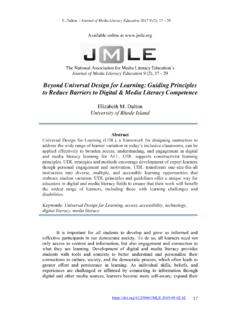Transcription of ELEMENTS AND PRINCIPLES OF GRAPHIC DESIGN
1 GRAPHIC DESIGN is about representation of ideas and concepts for communication or expression. It requires a visual medium of representation. A GRAPHIC DESIGN communicates through the visual language of dots, lines, shapes and colours. When we write something on a paper with black ink we read it because we see it first and then understand the meaning. Reading is nothing but first and foremost, a visual perception. Similarly, when we see a beautiful painting, it is a visual perception. Visual perception has two basic components. Firstly, there should be some material medium such as the white surface of a paper, or black ink, colours that result into dots, lines, shapes and so on. This material is called medium in GRAPHIC DESIGN . Material medium is a vehicle of visual perception. Secondly, visual perception happens through the eyes and, therefore, visual sensitivity is very important.
2 Material medium and visual sensitivity, both play an important role in GRAPHIC random scribbling of ink on paper is not called writing. Similarly, any random splash of colour on paper is not called a beautiful picture. Therefore, a disciplined or proper visual arrangement is required. Dots, lines, shapes, forms, colours are the basic ELEMENTS of GRAPHIC DESIGN without which GRAPHIC DESIGN is not possible. Similarly, there are time-tested rules or laws of arrangement of these ELEMENTS so that they will look beautiful and will be effective. These rules are called PRINCIPLES of visual composition. A GRAPHIC designer needs to learn and understand the role of basic ELEMENTS and PRINCIPLES of composition in DESIGN . They are the core of GRAPHIC DESIGN . These ELEMENTS and PRINCIPLES are discussed in detail here.
3 ELEMENTS AND PRINCIPLES OF GRAPHIC DESIGNG raphic DESIGN is about representation of ideas and concepts for communication or expression. It requires a visual medium of representation. A GRAPHIC DESIGN communicates through the visual language of dots, lines, shapes and colours. When we write something on a paper with black ink we read it because we see it first and then understand the meaning. Reading is nothing but first and foremost, a visual perception. Similarly, when we see a beautiful painting, it is a visual perception. Visual perception has two basic components. Firstly, there should be some material medium such as the white surface of a paper, or black ink, colours that result into dots, lines, shapes and so on. This material is called medium in GRAPHIC DESIGN . Material medium is a vehicle of visual perception.
4 Secondly, visual perception happens through the eyes and, therefore, visual sensitivity is very important. Material medium and visual sensitivity, both play an important role in GRAPHIC random scribbling of ink on paper is not called writing. Similarly, any random splash of colour on paper is not called a beautiful picture. Therefore, a disciplined or proper visual arrangement is required. Dots, lines, shapes, forms, colours are the basic ELEMENTS of GRAPHIC DESIGN without which GRAPHIC DESIGN is not possible. Similarly, there are time-tested rules or laws of arrangement of these ELEMENTS so that they will look beautiful and will be effective. These rules are called PRINCIPLES of visual composition. A GRAPHIC designer needs to learn and understand the role of basic ELEMENTS and PRINCIPLES of composition in DESIGN .
5 They are the core of GRAPHIC DESIGN . These ELEMENTS and PRINCIPLES are discussed in detail here. ELEMENTS AND PRINCIPLES OF GRAPHIC DESIGNFOUNDATIONS OF GRAPHIC DESIGN2425 ELEMENTS AND PRINCIPLES OF GRAPHIC DESIGNLet us first discuss the ELEMENTS of GRAPHIC DESIGN followed by PRINCIPLES of are three major categories of these ELEMENTS . Basic ELEMENTS Relational ELEMENTS Intentional elementsBasic ELEMENTS of composition are abstract concepts. They do not actually exist but seems to be present in a picture or in any visual representation. In geometry, a point is defined as an entity without length and breadth or an entity without any dimension. In GRAPHIC DESIGN , a point is represented in the form of a dot and it indicates a particular position. It is the end or the beginning of a line. Dot has a physical dimension which is a visual representation of an abstract concept also known as point.
6 For example, we feel that there is a point at the angle of a triangle or wherever two lines meet. This point is a basic element of is another interesting notion related to a dot . Assume that there is a bird sitting on a tree or near your window. You can see the bird in detail. When it starts flying and goes away from you, all the details get blurred and you just see a shape of a flying bird. As it goes further and further then even the shape also gets blurred and finally you see a dot . This dot need not be round in shape. It can have the shape of a flying bird reduced to its limits of recognition. It appears as a dot . Therefore, a dot can have any desired shape. A line is defined as a one-dimensional entity having length but no breadth. In GRAPHIC DESIGN , it is metaphorically defined as a line is a dot gone for a walk , that is, a line is a point in motion.
7 However, in GRAPHIC DESIGN a line is depicted where it has length as well as breadth. A line can be thin or thick. It can have many variations in thinness and thickness. ELEMENTS OF GRAPHIC DESIGNBASIC ELEMENTSP ointLineThinness or thickness of line creates a visual impact. A thick line appears heavy and a thin line appears lighter in a visual composition. Lines can be of various types. They can be straight, curved, zigzag, decorative, ornamental, vertical, horizontal, inclined, random or showing free movement. Each type of line will create a visual impact. If lines are grouped together then they will create even more visual horizontal lines create a feeling of calmness. Horizontal lines are stable. Vertical lines appear dynamic and may also suggest upward mobility. Inclined lines are unstable but may suggest growth or decay depending on the context of use.
8 Curved lines create various types of rhythmic movements while zigzag lines create a feeling of harshness. Decorative and ornamental lines create an impact of Indian tradition. In all the above cases, thickness and thinness of lines will either increase the visual impact or reduce the , depiction of line in GRAPHIC DESIGN is not just a representation of an abstract concept of a line but it is a representation of emotions, expression as well as a visual plane is defined as an entity with length and breadth but no depth. It is a two-dimensional flat or level surface. Space is defined as an infinite expansion. It is also defined as a collection of points in three dimensions. However, in GRAPHIC DESIGN space is defined in terms of its visual representation in a composition. Using the other ELEMENTS of DESIGN such as lines, colours and forms, it is possible to create an illusion of three-dimensional spaces or volume on two-dimensional PlaneSpaceFigure Scribbling drawingFigure PointsFigure thicknessDots of various Horizontal straight lines of varying thicknessFigure characteristicsLines of different Curved lineZigzag lineHorizontal rhythmic lineRightward slanted linesVertical straight linesRhythmic lines merging into each other to create meaningful formActivity 1 Collect images or photographs of lines from news papers.
9 Briefly describe the character and impact of lines in the collected dimensional objectVisual plane of three- Figure three-dimensional space by tonal variationVisual effect of FOUNDATIONS OF GRAPHIC DESIGN2425 ELEMENTS AND PRINCIPLES OF GRAPHIC DESIGNLet us first discuss the ELEMENTS of GRAPHIC DESIGN followed by PRINCIPLES of are three major categories of these ELEMENTS . Basic ELEMENTS Relational ELEMENTS Intentional elementsBasic ELEMENTS of composition are abstract concepts. They do not actually exist but seems to be present in a picture or in any visual representation. In geometry, a point is defined as an entity without length and breadth or an entity without any dimension. In GRAPHIC DESIGN , a point is represented in the form of a dot and it indicates a particular position. It is the end or the beginning of a line.
10 Dot has a physical dimension which is a visual representation of an abstract concept also known as point . For example, we feel that there is a point at the angle of a triangle or wherever two lines meet. This point is a basic element of is another interesting notion related to a dot . Assume that there is a bird sitting on a tree or near your window. You can see the bird in detail. When it starts flying and goes away from you, all the details get blurred and you just see a shape of a flying bird. As it goes further and further then even the shape also gets blurred and finally you see a dot . This dot need not be round in shape. It can have the shape of a flying bird reduced to its limits of recognition. It appears as a dot . Therefore, a dot can have any desired shape. A line is defined as a one-dimensional entity having length but no breadth.

















